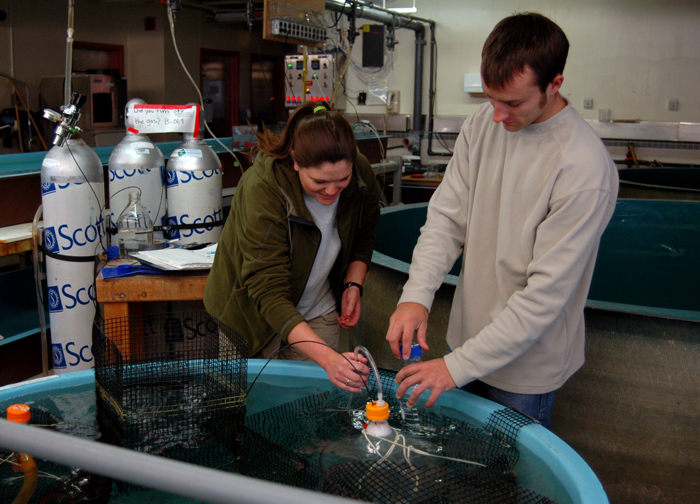
Photo Credit: Peter Rejcek |
Graduate student Tansey Hall, left, and undergraduate John Tollison bubble water in the aquarium room located in the Albert P. Crary Science and Engineering Center at McMurdo Station. They are increasing the acidity of the ocean water to see how the calcified shells of small ocean critters called pteropods are affected. |
Ocean acidification
Calcifying sea critters may pay the price for increasing levels of carbon dioxide in the atmosphere
By Peter Rejcek, Antarctic Sun Editor
Posted February 8, 2008
Victoria Fabry and Brad Seibel study what’s come to be known as “the other CO2 problem.”
Most of us are familiar with the first problem: The copious discharge of carbon dioxide, the primary greenhouse gas, into the atmosphere is forcing the Earth’s temperature to rise, causing a wide range of disruptions and changes to the world’s climate.
The oceans play an integral role in mitigating some of that CO2 by absorbing about a third of it as what scientists call a “carbon sink.” But that benefit comes at a cost to marine critters and ecosystems, as the carbon dioxide begins to change the seawater chemistry of the oceans.
A leading expert in ocean acidification from California State University San Marcos, Fabry is the principal investigator for a team of scientists in Antarctica studying how Southern Ocean pteropods, small gastropod mollusks (sea snails and slugs), may respond to higher acidic levels of seawater predicted for the next century.
These animals may be particularly vulnerable to seawater chemistry change because, as the oceans become more acidified and the pH level decreases, their ability to calcify and form shells and skeletons may be severely affected.
“Ocean acidification is going to impact many organisms that calcify,” Fabry said from her office at the Albert P. Crary Engineering and Science Center in McMurdo Station. “It’s going to happen in our lifetimes. It’s not far away.”
The pH level, measured in units, is a calculation of the balance of a liquid’s acidity and alkalinity. The lower a liquid’s pH number, the higher its acidity. The pH level for the world’s oceans was stable for tens of thousands of years, but has dropped one-tenth of a unit since the Industrial Revolution in the 1800s.
That represents a significant decrease, Fabry said, and current models predict the pH level may drop by as much as four-tenths of a unit by 2100 relative to the pre-industrial value. That could mean big trouble for calcifying organisms, particularly in the higher latitudes of the Arctic and Antarctic.
The reason: Most pteropods and other calcifiers, like corals, use the calcium carbonate minerals of calcite or aragonite to construct their shell coverings or skeletons. Normally, surface seawater is not corrosive to calcite and aragonite because the carbonate ion is at supersaturating concentrations. However, as ocean pH falls, so does the concentration of the carbonate ion.
Higher latitude waters are naturally less saturated, so the change in chemistry would affect these areas first. By 2040, under some CO2 emissions scenarios, surface waters of some regions may become undersaturated of aragonite, making those calcium carbonate structures constructed of aragonite vulnerable to dissolution.
At the end of the century, projections say most of the Southern Ocean and some regions of the subarctic Pacific will become undersaturated with respect to aragonite if CO2 emissions continue in a business-as-usual scenario. Data on the Arctic Ocean are pending.
“The high latitudes are the first areas that will have large expanses of surface waters that will be undersaturated with respect to aragonite. It’s not looking good,” Fabry said. “With increasing oceanic uptake of atmospheric CO2, we see CO2 increasing in the water and pH declining at time series stations at Bermuda, Hawaii and the Canary Islands. … And in high latitudes such as the Southern Ocean, what we’re going to have in the coming decades is surface seawater that is corrosive to aragonite. ”
1 2 Next





